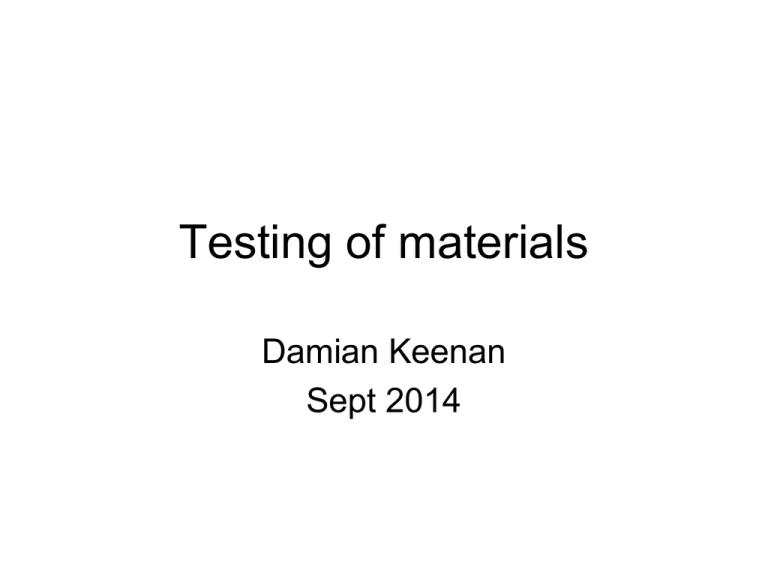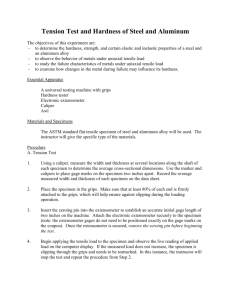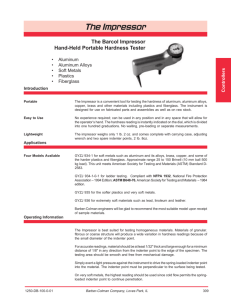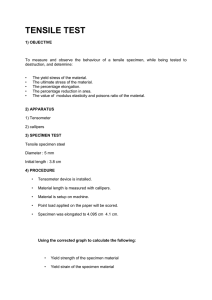here - Summerhill College
advertisement

Testing of materials Damian Keenan Sept 2014 • There are two main categories of materials testing; • 1. Destructive Testing • 2. Non-destructive Testing • The types of destructive tests used in Engineering are; • Tensile Test • Hardness Test • Toughness Test • Creep Test • Fatigue Test • The types of non-destructive tests used in engineering are; • Visual Inspection • Dye Penetrant Test • Magnetic Particle Test • Eddy Current Test • Ultrasonic Test • X-Ray Test Tensile Testing • Tensile testing involves the stretching of a piece of material, or putting it under strain, and examining how it behaves under test. • The ductility of a metal can be found by tensile testing using an extensometer, which is an instrument for measuring the amount that a specimen stretches or extends during a test. • These specimens may be rectangular or circular but must have a specified cross sectional area (CSA). • They also must have punch marks a specified distance apart (Gauge Length). Tensile Test Specimens The Test Procedure • The specimen is set up in the tensile testing machine, the extensometer. • One end is held in a vice and the other in a holding system. • A controlled load, measured in newtons (N), is applied. • The amount of stretch or extension that this force causes is measured. • A material that returns to its original length has elasticity. Repeated test are carried out making the load greater each time. • While the material under test has elasticity the extension or stretch is directly proportional to the load. • This is known as Hookes Law. Metals are elastic in the early stage of tensile testing, plastics are not. • When a material fails to return to its original length it has reached its elastic limit or limit of proportionality. • After the elastic limit the loads produce much larger extensions of the specimen. This is called the plastic region. • At the end of this stage, the extension is even greater and a yield point is reached. • A further increase in the load causes the specimen to thin uniformly and then to neck. After necking the specimen will break or fracture. • When the fracture occurs one side of the specimen has a rough cone shape and the other has a rough cup shape. • This is known as a cup and cone fracture Stress • Stress can be defined as the amount of load or force carried by a unit area. It is normally written as Newtons per millimetre squared, (N/mm2). • Stress = Load Cross Sectional Area (CSA) If a bar, 15mm wide X 8mm deep, is pulled with a force of 360 kN, the stress is found as follows. Force = 360 kN Cross Sectional Area (CSA) = 120 mm2 (15mm X 8mm) Stress = 360kN 120mm2 = 3 kN/mm2 Young’s Modulus of Elasticity In the elastic range of a material, stress is directly proportional to strain, which is another way of stating Hookes Law. This is called Young’s Modulus, is represented by ‘E’ and measured in kN/mm2. Tensile Strength Tensile strength is the maximum force of load, in Newtons, applied to the specimen before it fractures divided by the original cross sectional area. Proof Stress • Some materials do not have a well defined yield point or an indication at what stress yield occurs. • To overcome this, a value of stress, known as proof stress is used. Reading 0.1% Proof Stress from a forceextension graph • A distance equal to 0.1% of the gauge length, from the origin, is located. • If the gauge length is 56mm, then the distance from the origin for 0.1% proof stress is 0.056mm • A line, parallel to the straight part of the graph, is drawn from the 0.056mm mark until it cuts the graph line. • The stress at that point is the 0.1% proof stress. Reading 0.1% Proof Stress from a stressstrain graph • Proof stress is much easier to find from a stress-strain graph. Proof stress is read almost directly from this type of graph • If the 0.1% proof stress is required, then a line is drawn from 0.001 strain, parallel to the straight part of the graph. Youngs Modulus of Elasticity = Stress / Strain Stress = Load / CSA Strain = Extension / Original Length = 50 / 78.5 = 0.2 / 50 = 0.64 = 0.004 Youngs Modulus of Elasticity = Stress / Strain = 0.64 / 0.004 = 160 kN / mm2 Hardness of Materials • Hardness is tested by measuring the material’s resistance to indentation or scratching of its surface. • Hardness in metals may vary or can be changed by heat treatment. • 1. The Brinell Test, which uses a ball indenter • 2. The Vickers Test, which uses a diamond, square based pyramid indenter • 3. The Rockwell Test, which uses a steel ball for soft materials and a diamond cone for hard materials The Brinell Test • Indenter:Hardened steel or Tungsten Carbide ball, • Procedure:Ball indenter forced into the surface of the test piece by a suitable load. • Diameter of indentation is measured and converted into a Brinell hardness number. • The test piece must be 8 times thicker than the depth of the impression to prevent the table of the test machine absorbing the indenting force. • Uses: Used on iron castings and drop forgings. • Disadvantages: Cannot be used on thin material specimens. • Ball deforms with very hard material specimens. • Ball indents too much with soft material specimens The Vickers Test • Indenter: Diamond, square based pyramid – point angle of 136° • Procedure: Diamond indenter forced into the surface of the material being tested making a square shaped impression. • The diamond pyramid is less likely to distort under high forces than the steel ball. • The diagonal length of the impression is measured and this measurement is converted into a Vickers hardness number. • The test piece must be 5 times thicker than the depth of penetration required. • Uses – Used for very hard materials, gives a more accurate reading than Brinell. • Easier to use. A smoother surface is required on test pieces, which makes this method ideal for finished components The Rockwell Test • Indenter: The two most common indenters are the Ball and Cone. • Procedure: Similar to the Vickers process. • Rockwell system has a large range of hardness scales. • Each scale has its own type and size of indenter, as well as a specified indenting force. • ‘C’ scale indicates that a Cone was used and ‘B’ scale indicates that a Ball was used. The ball is used for soft materials and the cone is used for hard materials. • Note: Both the Brinell and Vickers hardness tests measure the surface areas that the indenters make, to determine the hardness numbers. but the Rockwell test measures how far the indenter moves into the material being tested. Toughness Testing • Toughness testing can also be called Impact Testing or Notched Bar Testing. • The two common methods of Impact testing are • The Izod Test • The Charpy Test Diagram of Impact Testing Machine • Procedure - Notched specimens are held in a vice and are struck by a weighted pendulum. • The energy absorbed in breaking the test piece is measured and a value for toughness is given. • The height that the pendulum swings to after breaking the specimen indicates how much energy was absorbed. The Izod Test • Specimen is held vertically, • Notch is facing the pendulum • Striking energy of 167 Joules • ‘I’ for Izod and the specimen • stands in the vice like an ‘I’. The Charpy Test • Specimen is held horizontally, • Notch is facing away from the pendulum, • Striking energy of 300 Joules – greater than the Izod because the pendulum is released from a higher position, • A different striker is fitted for this test – a knife edge striker Non Destructive Testing (NDT) • The types of non-destructive tests used in engineering are; • Visual Inspection • Dye Penetrant Test • Magnetic Particle Test • Eddy Current Test • Ultrasonic Test • X-Ray Test • This testing does not damage the material or the components being tested or impair its intended use • The components are first produced and then tested. • Surface flaws and internal flaws can be detected. • Ideal for quality control and random sampling. • Can be completed on site. Detection of Surface Flaws 1. Visual Inspection • Cheapest and simplest technique in detecting surface flaws • Good light is essential and usually some form of magnification is used. • A disadvantage is that even with magnification of up to 5 times some surface flaws may not be noticed. Detection of Surface Flaws 2. Dye Penetrant test • Coloured Dye is applied to the surface & allowed to penetrate into any surface flaws by means of capillary action. • The excess liquid is wiped off the surface after a sufficient time has elapsed. • The surface is then examined under a light. A white light is used when a coloured dye is used, • An ultraviolet light is used when a fluorescent dye is being used. Below the Surface Detection Thermal Testing • These are based on the high thermal conductivity of metals. • Any flaw present will affect the heat transfer in the metal being tested and is shown up by the use of heat-sensitive coatings Below the Surface Detection Magnetic Methods of Testing • In ferro-magnetic materials, cracks and cavities cause distortions in magnetic fields set up in components under test. • There are variations of these tests. 1. Magnetic Particle Method 2. Eddy Current Testing Magnetic Particle Testing • Can detect surface flaws or flaws very near the surface. • Flaws show up best when the crack/flaw is at right angles to the magnetic field. • Wet, dry or fluorescent magnetic particles are applied to the surface of the component. • A distorted magnetic field will be displayed if a flaw is present. • Difficult to use with rough surfaces. • Components must be demagnetised after testing. Ultrasonic Testing • This type of testing involves the use of a quartz crystal to generate high frequency sound vibrations. • A probe containing the quartz crystal is passed over the test piece. • The vibrations are reflected back by the lower surface of the material and are recorded by a receiver. • In most modern testing devices the quartz crystal acts as both the transmitter and receiver. Eddy Current Testing • Can detect surface flaws or flaws very near the surface. • Used widely for non-ferrous metals, mainly for bars of uniform section. • Uses electromagnetic energy detect defects in a component • An AC induction coil is used to produce Eddy currents in the metal under test. Eddy currents are secondary currents induced in a conductor. These currents produce a magnetic field in the component • The magnetic field in the test piece and that in the coil oppose one another and cause changes in the current flow in the coil. • All current changes are displayed on an oscilloscope. • The crystal converts the pulses and echoes into an electrical signal which is amplified and displayed on the cathode-ray tube (CRT). • Ultrasonic testing is a rapid method of NDT and can be used to test most materials and in great depths (10 m or more for steel). • Used in the fishing industry to detect the depth of the water and for locating fish. • Used in engineering for the testing and inspection of welds. X-Ray Testing (Radiographic) • X-Rays can penetrate materials which ordinary light will not. An X-Ray tube emits rays of radiation which pass through the component. • These rays form an image on photographic film behind the component. A fault will be displayed on this film as it will have absorbed less radiation; it is displayed by a darker image on the film. • X-Rays used for NDT are more dangerous than those used in medicine so great care must be taken to shield from stray radiation. • This type of testing is used extensively for the testing of welds.





